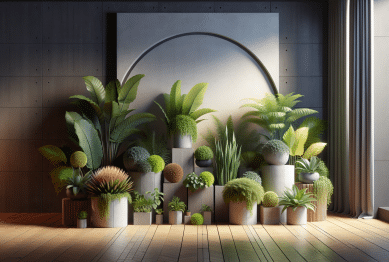Discover creative strategies for maximizing small garden areas without sacrificing style or productivity. This guide highlights effective gardening layouts, vertical solutions, and plant selection techniques so you can enjoy a lush oasis, even when outdoor space is limited.
Rethinking Garden Layout for Limited Spaces
Designing a garden when space is restricted may seem challenging, but with smart planning, small areas can become surprisingly productive. Efficient layouts—such as raised beds, container clusters, and zigzagging paths—help squeeze more greenery into every inch. Whether you have a compact backyard or a balcony, optimizing layout means you can fit more variety, experiment with creative arrangements, and simplify maintenance. Grouping plants with similar growth habits together not only maximizes sunlight exposure but also reduces the need for excessive tools and resources.
Consider a modular approach to garden design. This involves dividing the space into designated zones, each serving a specific function like herbs, vegetables, or decorative flowers. Each module can be rearranged seasonally for rotation or aesthetic appeal. Utilize trellises along borders to push climbing vegetables upward, freeing ground room for low-growing crops. Geometry plays an important role; using hexagonal or triangular raised beds lets you avoid wasted space in tight corners and provides interesting focal points.
Don’t overlook flexible furniture and pathways in your layout plan. Fold-away benches or wheelbarrow-friendly walkways can help you navigate and maintain the garden without encroaching on plant beds. A thoughtfully planned small garden can look open and spacious, even with dense planting. By harmonizing seating, planters, and footpaths, any outdoor area—no matter its size—becomes a dynamic, functional sanctuary. Experiment with double-border plantings and curved beds for a sense of abundance without crowding.
Vertical Gardening as a Game-Changer
Vertical gardening is transformative for maximizing small spaces. By growing up instead of out, gardeners can multiply planting opportunities with trellises, wall-mounted containers, or hanging pockets. This style is perfect for vine crops like tomatoes, peas, and cucumbers, as well as decorative cascades of nasturtium or petunias. In urban homes, vertical planters offer a solution for rooftops and balconies. They allow light-loving plants prime exposure while freeing precious ground space for root vegetables or shaded herbs.
Innovative materials facilitate accessible vertical installations. Sturdy wire meshes, recycled wooden pallets, or professional-grade green walls each suit different garden aesthetics and budgets. Regular watering is essential; gravity accelerates the drying of elevated soil, so self-watering systems or drip irrigation may be helpful for consistent hydration. With careful plant selection, lush living walls can also improve microclimates, offering shade and cooling both for the garden and the living space nearby.
Vertical gardening doesn’t need to be complex. Even a simple series of shelves or large stacked pots can expand your plant palette. Flowers, leafy greens, and strawberries thrive in compact tower gardens. Many gardeners also mix edible crops and ornamentals, creating attractive walls that feed both body and senses. Such vertical solutions demonstrate that almost any sunny or partially shaded wall has potential as productive growing area.
Smart Plant Selection: Choose Wisely for Abundance
Plant choice is pivotal when trying to maximize a garden’s output. Opting for compact or dwarf cultivars can double planting density without crowding. Lettuce, radishes, carrots, and spinach are excellent for successive planting, offering ongoing harvests from a single patch. Look for multi-cropping varieties and those suited to close spacing; they thrive when sown thickly or set in clusters. Mixing perennials with annuals introduces subtle structure and ensures year-round growth and color.
Growers with small gardens often benefit from scheduling— swapping out cool-season crops in spring for heat-loving varieties come summer. Interplanting shallow-rooted herbs like basil near larger tomatoes exemplifies harmonious cohabitation. This approach also deters pests, as different plant scents and root structures confuse would-be invaders and reduce the risk of disease spread. Edible flowers like calendula or nasturtium add color and flavor, while pollinator-friendly blooms bring in beneficial insects to maximize productivity.
Even within restricted dimensions, diversity is possible. Companion planting—growing plants that bolster each other—enables small gardens to thrive without extensive chemical support. Beans fix nitrogen, enriching soil for neighboring crops. Chives and garlic can deter aphids and beetles, while leafy greens provide quick, repeated harvests between slower-growing vegetables. Careful selection means minimum waste and maximum reward—both aesthetically and in the harvest gathered from your creative patch.
Utilizing Containers and Portable Planters
Containers are a versatile solution for gardeners seeking flexibility or working with paved courtyards and balconies. They let you move plants to favor sunlight, shield against harsh weather, or even change garden layouts with the seasons. Many edible and ornamental plants are remarkably well-suited to containers, including cherry tomatoes, peppers, blueberries, and compact roses. Mix pot shapes and sizes to create visual interest and fit odd spaces, from stairwells to windowsills.
Container gardening simplifies soil control and pest management. Using premium potting mixes ensures optimum nutrients and drainage for each plant, while isolated setups minimize the spread of root diseases. Regular feeding supports sustained growth as nutrients are rapidly depleted in pots. With smart systems, such as self-watering containers or drip feeders, containers require little maintenance but still deliver impressive results.
In addition, containers are ideal for experimenting. Trying out unusual crops or new cultivars in a confined environment reduces risk and encourages creativity. Window boxes, barrel halves, vintage crates, or upcycled buckets all work. Rotate plants for sunlight or to refresh the look, and combine herbs and flowers for both utility and beauty. For renters or those with seasonal homes, portability makes it simple to redeploy the entire garden as circumstances change.
Maintenance Tips for Thriving in Limited Spaces
Keeping a high-density or compact garden healthy means paying close attention to maintenance routines. Small gardens dry out more quickly, especially when relying on containers or vertical setups. Regular, even watering and mulching help maintain consistent moisture. Using organic matter in small doses rewards the soil without creating imbalance. Keep growth in check by pruning, thinning, and removing any diseased leaves to allow for proper air circulation.
Effective pest control is more crucial since infestations can spread rapidly across closely spaced plants. Physical barriers, companion plants, and natural predators aid in cultivating a balanced ecosystem. Frequent check-ins make it easier to spot problems early. Gardeners also benefit from composting kitchen scraps to boost soil health, reducing waste and encouraging strong growth. With small plots, even little changes can make a noticeable difference.
Finally, flexibility is key for success in limited spaces. Be willing to rearrange furniture, add new planters, or swap plant arrangements each season. This adaptive mindset allows maximum use of available sunlight and takes advantage of seasonal weather shifts. Try journal-keeping for tracking which layouts and varieties perform best. Over time, the garden becomes not only productive, but a true reflection of your evolving space and needs.
Inspiring Examples and Further Ideas
Countless home gardeners have transformed tiny balconies, patios, or even windowsills into lush paradise zones. Community gardens in urban neighborhoods often employ vertical beds and raised containers, yielding bountiful harvests for families. Many public gardening organizations share design templates and seasonal planting guides specific to small-space conditions, making creative cultivation accessible regardless of experience or location. Explore resources online for established layouts and helpful tutorials.
Seasonal festivals and open garden tours reveal what’s possible with limited square footage. From edible walls to tiered floral displays, there’s inspiration everywhere. Many gardeners favor repurposed materials, including pallets, guttering, or reclaimed wood, to assemble practical but charming garden structures. Guided local workshops and nonprofit organizations frequently offer advice and support for maximizing small home gardens, ensuring a network of expertise is always at hand.
Online communities are another valuable asset for sharing success stories, troubleshooting issues, and exchanging innovative design ideas. Several public university extension programs and botanical gardens maintain active forums, webinars, and fact sheets to help any gardener scale new heights, regardless of the space or resources available. Community-driven content often showcases what works under real-world conditions, offering step-by-step guidance for creating abundant gardens in surprising places.
References
1. University of Illinois Extension. (n.d.). Small Space Gardening. Retrieved from https://extension.illinois.edu/gardeners-corner/small-space-gardening
2. Royal Horticultural Society. (n.d.). Small Gardens. Retrieved from https://www.rhs.org.uk/garden-inspiration/advice/small-gardens
3. Cornell University Cooperative Extension. (n.d.). Vegetable Garden Planning and Layout. Retrieved from http://gardening.cals.cornell.edu/vegetable-gardening/plan/
4. UC Master Gardener Program. (n.d.). Container Gardening Tips. Retrieved from https://mg.ucanr.edu/Take_a_Class/Container_Gardening/
5. PennState Extension. (n.d.). Maximizing Yields in Small Spaces. Retrieved from https://extension.psu.edu/maximizing-garden-yields-in-small-spaces
6. Colorado State University Extension. (n.d.). Gardening in Small Spaces. Retrieved from https://extension.colostate.edu/topic-areas/yard-garden/gardening-in-small-spaces-7-248/











 You Can Understand Artificial Intelligence Easily
You Can Understand Artificial Intelligence Easily 

